
- Home
- Travel Packages
- Top Destination
-
Travel Attraction
By Category
Top Attraction
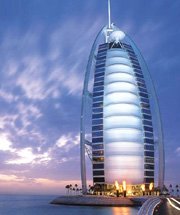
- Travel Agents
- Car Rentals
- Hotels
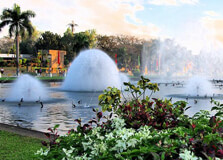
Rizal Park is a historical urban park. It is reckoned as the Asia’s largest urban park and also called Luneta Park. The park is situated along Roxas Boulevard, City of Manila, Philippines. It can be located adjacent to Intramuros. The park is visited by many on weekends and national holidays. History The land on which the park is straddled was the location of a town called Nuevo Barrio. During 1762 to 1764, the town was ruined by British, and the location came to be known as Bagumbayan Field. In 1995, Luneta was declared a national park after President Ramon Magsaysay signed Proclamation No. 234. Park Sections · Northeastern Section: It includes the 16-hectare (40-acre) Teodora F. Valencia Circle adjoining Taft Avenue. · Central Section: It is a 22-hectare (54-acre) park and extends down to Roxas Boulevard. · Southwestern Section: It comprises of Burnham Green, a 10-hectare (25-acre) open field, Manila Ocean Park along Manila Bay and the Quirino Grandstand. Recent Events in Park · In January 18 2015, the largest papal gathering was held here. · The Million People March was organized in the park in August 22–26, 2013. · Pentecostal Missionary Church of Christ (4th Watch) organized International Missionary Day at Quirino Grandstand in January 17, 2010 in the park.
Explore More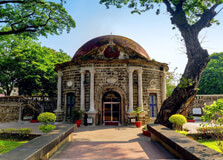
Paco Park stretches upto an area of 4,114.80 m2 (44,291.3 sq ft). It is a recreational garden area and situated in General Luna St. It is precisely located at the east end of Padre Faura Street in Paco district in the City of Manila, the Philippines. If one turns the pages of history, it can be found that Paco Park was once a Manila’s municipal cemetery. It is said that it was constructed by the Dominicans. History Paco Park was initially designed as a municipal cemetery for the rich and aristocratic Spanish families living in old Manila. The park was also used by Japanese forces in the second world war as central supply and ammunition depot. In the year 1966, the park was turned into National Park. Architecture Paco Park is expounded by circular shape. It has an inner circular fort, which is referred to as the original cemetery. The walls were contrived to be hollow, so that these could easily serve the purpose of niches. Later, the second outer wall was also built. For making promenades, the top of the walls were turned into pathways. The inside of the walls also has domed Roman Catholic chapel. It is small in size and dedicated to St. Pancratius.
Explore More
Comprising of three waterfalls, the Kawasan Falls is just 130 kilometers southwest of Cebu City. The Kawasan Falls is located inside the mountains of Barangay amid scenic forests. A trek uphill for 30 minutes from the entrance will get to the first and largest waterfall. Another uphill climb of 15 minutes will take you to the second waterfall. The third waterfall is another 15 minutes uphill trek from the second falls. Simple and serene, Kawasan Falls is the favorite destination of tourists from around the world. The lush green forecasts, and crystal clear waters make it the perfect get-away destination. Highlights· The biggest highlight of any visit to the fall is a dip in the refreshing swimming holes with milky blue colored water.· Refreshing shower massage under the falling water is something a tourist must try during the visit.· Rafts are available on rent to take the tourists around the pool. Overnight stay· Cottages, rooms and resorts with all the basic amenities are available for rent and overnight stay. Shops and resorts· Along the uphill trek, there are different shops selling souvenirs like beaded necklace, bracelets, and Kawasan print t-shirts. One can taste the local delicacies in the resort’s restaurants.
Explore More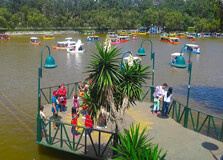
Burnham Park is an urban park and stretches upto the area of 32.84 hectare. It is situated in Baguio City in the Philippines, and derives its name from American architect and urban planner, Daniel Hudson Burnham. Former recreational base of the United States Armed Forces in the Philippines, Camp John Hay can also be reached easily from the park. There are many stretches of road around the park. Important Event in History In 1990, Luzon earthquake lead to the death of many people in Baguio and many became homeless. The park gave shelter to many people. Facilities Burnham Lake: It is a man-made lake and situated in the center of the park. The tourists can also wallow in boating in the lake. Children Playground: There is also a children playground inside Burnham Park. A Memorandum of Agreement (MOA) has also been signed by the Government of Baguio City and SM Prime Holdings Inc. for enhancing and rehabilitating the children park. Skating Rink: There is also a public ice rink in the park. The visitors can enjoy ice skating here by procuring ice skates on rent. Rose Garden: The Rose Garden in the park also exhibits the bust of Daniel Burnham. Orchidarium: Park has a beautiful orchid house. The visitors can see variety of orchids and flowers here.
Explore More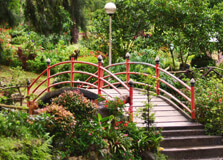
Baguio Botanical Garden is a large park like Burnham Park and situated towards the east of Baguio's downtown area. The main entrance of the garden is along the Leonard Wood Road. It is also referred as Igorot Village. Highlights of Garden · It has many native huts, which are very much like the Igorot dwellings found in the Cordilleras. · It features an ethnic spirit and depicts the culture of the Igorots too. · It is a serene place and one can spend tranquil moments here. · There are narrow and winding pathways in the park to enjoy strolls. · The landscapes in the park have many plants and trees. Opportunity to Explore Igorot Culture The group of Igorots welcomes the visitors to the park at the entrance. These people are clad in their native clothes and regalia. The visitors can also request them to pose for the pictures that would make for perfect souvenirs. Plants for Sale There are many types of plants available for sale in the garden. While buying, the visitors should keep in mind that some plants cannot be replanted in lowland areas. One can also take pictures of the resplendent flowers and verdant plants during ones visit.
Explore More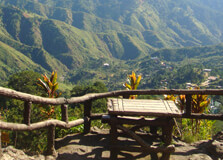
Mines View Park is situated on the northeastern peripheries of Baguio City in the Philippines. It is precisely located four kilometers away from downtown Baguio. Many travelers who come to visit Mansion or Wright Park never miss visiting Mines View Park as the two parks are very near. Fog starts encompassing the park during afternoon for some months, so any visit should be made earlier during the day. Facilities · There are several stalls at the entrance of the park. The visitors can buy variety of native handicrafts like baskets, wood carvings, blankets, brooms, locally made silver products & jewelry etc. from these stalls. · Visitors can also savor toothsome food from canteens and snack stores. The street vendors also sell variety of delectable eatables and beverages in the surrounding park area. · The vehicles can be parked at the parking area. · One can procure the services of commercial photographers to get the pictures clicked. Observation Deck Visitors can enjoy picturesque views from the observation deck. The deck can be reached by treading winding stone-covered stairway located near the parking area. The stairway turns very slippery after the rain and one should be very careful while walking. Visitors can also sit on benches at the promontory. Beautiful Sights · The park gives a nice view of the mining town of Itogon sprawling below. · One can see the deserted gold and copper mines of the Benguet Corporation slumping below, from the park. · One can also catch sight of the Amburayan Valley from the park.
Explore More
Wright Park is situated at the eastern part of Baguio city. It is counted amongst the many splendid parks located in the city. The park is haven to a long rectangular body of water having little depth. It is called the “Pool of Pines”. The park circle is located on the park’s one end. The park also havens many tall pine trees. The decorative street lights accentuate the aesthetic appeal of the park at the access road beside the pool. Take Pictures Post card type photographs can be clicked at the both ends of the park. Visitors can also carry a camera with them during their visit to the park. Get Acquainted with Igorot Culture · Visitors can spot Igorots donned in their native clothes and regalia in the park. The Igorots in the park are always happy to get clicked with the visitors at a nominal fee. · Visitors can also purchase native handicrafts at the Mansion end of the park. Ponies on Rent There is a walkway from the park circle, which can be treaded to reach a wide stairway. The stairway is contrived with stones and takes the visitors to a place where they can easily get ponies on rent. The ponies can be rented to wander along South Drive, the Mines View Park area or to Outlook Drive
Explore More
Known to be traditional gardens, Japanese Gardens are characterized by miniature idealized landscapes. The gardens of Buddhist temples have been designed for meditating and contemplating purposes. The gardens of the emperors and nobles are contrived to make one enjoy quality recreation time in the aesthetic surroundings. Japanese garden styles include: Karesansui, Japanese Rock Gardens or Zen Gardens: These are meditation gardens and known as gardens where white sand takes place of water. Roji, Simple, Rustic Gardens with Teahouses: Here Japanese tea ceremony is organized. Kaiyū-shiki-teien, Promenade or Stroll Gardens: Here the visitors can walk along the path around the garden, and feast the senses watching the composed landscapes. Tsubo-Niwa, Small Courtyard Gardens. Various Garden Elements Water: Japanese gardens have beautiful ponds or streams. The dry rock garden does not have water but the water is represented by white sand. Rocks, Sand & Gravel: Japanese garden comprises of rock, sand and gravel. While the vertical rock represents Mount Horai, and the flat rock represents the earth. Sand and gravel in the garden can mean beach, or flowing river. Bridges: Bridges in the garden are made of stone and wood. There are also bridges in the garden made of logs having earth on the top, and are covered with moss.
Explore More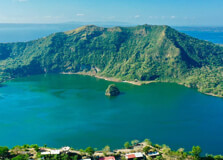
Taal Lake is a stunning crater lake situated in the province of Batangas, Philippines, and is a popular natural wonder located near the scenic town of Tagaytay. Known for its unique geography, Taal Lake is one of the country’s most famous tourist attractions, drawing visitors for its natural beauty, serene atmosphere, and the active Taal Volcano that sits at its center. The lake’s combination of lush surroundings, volcano views, and nearby town of Tagaytay makes it a must-see destination for travelers looking to explore the best of nature and adventure. How to Reach Taal Lake, Tagaytay, Philippines Getting to Taal Lake is relatively easy for travelers, especially those coming from Metro Manila. The lake is about 60 kilometers south of the capital city, and the most common route to reach it is via the South Luzon Expressway (SLEX). From Manila, you can take the SLEX and exit at Santa Rosa, then drive towards Tagaytay, a popular hilltop town. Once in Tagaytay, signs will guide you to the various boat stations for Taal Lake. Alternatively, you can take a bus from Pasay or Buendia terminals in Manila that travels directly to Tagaytay. After reaching Tagaytay, you can hire a tricycle or a local jeepney to take you to the designated boat stations near the lake’s shore, where boats depart to Taal Volcano. Weather at Taal Lake, Tagaytay, Philippines The weather in Tagaytay and the surrounding areas, including Taal Lake, is generally cool and mild, making it a year-round destination. Due to its higher elevation, Tagaytay enjoys a cooler climate compared to the lowland areas of Metro Manila. The temperature in Tagaytay typically ranges between 22°C to 30°C, with cooler temperatures especially in the evening. Tagaytay and Taal Lake have a tropical climate, with a rainy season from June to November, and the dry season lasting from December to May. The best time to visit is during the dry season, as this allows visitors to enjoy clear skies and optimal conditions for a boat ride on the lake. Why Taal Lake, Tagaytay, Philippines is Famous Taal Lake is famous for its unique geological features. The lake itself is situated inside a caldera, which is a large volcanic crater formed by a massive eruption millions of years ago. At the center of the lake is Taal Volcano, one of the most active volcanoes in the Philippines. The presence of an active volcano inside the lake gives Taal a distinct landscape, with steam vents and fumaroles visible on the island. Another reason for its fame is the picturesque views it offers. The Taal Volcano Island is visible from Tagaytay, and the surrounding area is perfect for sightseeing, hiking, and boating. The calm waters of the lake, combined with the towering volcano, make it one of the most photogenic locations in the country. Entry and Visit Details about Taal Lake, Tagaytay, Philippines There is no direct entry fee for visiting Taal Lake. However, visitors will need to pay for a boat ride to reach the Taal Volcano Island, where most of the activities take place. The boat ride is usually arranged through local tour operators located at designated boat stations near the lake’s shore. Prices for the boat ride can vary depending on the size of the group and the type of service offered, but they generally range from PHP 1,500 to PHP 3,000 per boat ride (which can accommodate up to 6 people). Once on the island, you will need to pay an entrance fee, which is generally around PHP 100 per person. Visitors may also choose to hire a guide for a more informative experience, which costs extra. The entrance fees and boat rides help fund the maintenance of the area and the safety measures, especially in light of the volcano’s active status. History and Architecture of Taal Lake, Tagaytay, Philippines The history of Taal Lake is deeply intertwined with the active Taal Volcano. The volcano has erupted numerous times throughout history, with the most catastrophic eruptions occurring in 1754 and in recent years, such as the eruption in January 2020. The lake itself was formed as a result of volcanic activity millions of years ago, and its caldera remains an important part of the region’s geological landscape. The architectural structures around the lake and the nearby Tagaytay region reflect a mixture of modern and traditional Filipino designs. The town of Tagaytay features several restaurants, cafes, and hotels offering panoramic views of the lake and volcano. You can find Spanish-influenced churches, such as the Our Lady of Lourdes Parish, which is a key feature of the town’s architecture. Things to Do at Taal Lake, Tagaytay, Philippines There are a variety of activities for visitors to enjoy when visiting Taal Lake and its surrounding areas: Boat Ride to Taal Volcano Island: The most popular activity is taking a boat ride across the lake to Taal Volcano Island, where you can hike to the crater and observe the active volcano. Hiking: Hiking to the summit of Taal Volcano provides stunning views of the surrounding area and the crater lake. The hike is moderate and takes around 30-45 minutes, depending on your pace. Horseback Riding: For those who prefer not to hike, horseback riding is a common way to reach the volcano’s summit. This is a fun and scenic alternative. Relaxing at Tagaytay: After visiting Taal Lake, you can unwind in the cooler climate of Tagaytay, with several parks and cafes offering spectacular views of the lake and volcano. Interesting Facts About Taal Lake, Tagaytay, Philippines Taal Lake is the largest lake in the province of Batangas. The lake is located at an elevation of around 150 meters above sea level. Taal Volcano is the second-most active volcano in the Philippines. The volcano island inside the lake is home to both a volcanic crater and a small lake within the crater, known as the "Main Crater Lake." Tips for Visiting Taal Lake, Tagaytay, Philippines Wear Comfortable Footwear: If you're planning to hike or ride horses to the volcano, wear comfortable shoes or sandals that are suitable for walking on rocky terrain. Bring Sunscreen: The sun can be intense, so be sure to apply sunscreen before heading out for a boat ride or hike. Stay Hydrated: The hike to the volcano can be tiring, so carry water with you to stay hydrated. Check Weather Conditions: Always check the weather forecast before visiting, as the area can be affected by rain or volcanic activity. Respect the Environment: Be mindful of the environment and follow any guidelines provided by local authorities, especially around the volcano.
Explore More
Sky Ranch Tagaytay is a popular amusement park located in the scenic town of Tagaytay, Cavite, Philippines. Known for its stunning views of the Taal Volcano and the surrounding landscapes, Sky Ranch offers visitors a unique blend of exciting rides, family-friendly activities, and breathtaking vistas. Whether you’re a thrill-seeker looking for adventurous rides or someone who simply wants to relax while taking in the view, Sky Ranch has something for everyone. How to Reach Sky Ranch Tagaytay, Philippines Sky Ranch is conveniently located in Tagaytay, making it easily accessible from Metro Manila. The most common route is via the South Luzon Expressway (SLEX). If you're traveling by car, simply take the SLEX and exit at Santa Rosa, then follow the signs leading you to Tagaytay. Sky Ranch is located along Aguinaldo Highway, which is the main road in the town. If you prefer public transportation, you can take a bus from Pasay or Buendia terminals in Manila, which are the primary terminals for buses going to Tagaytay. The journey typically takes around 1.5 to 2 hours, depending on traffic. Once you arrive in Tagaytay, Sky Ranch is a short tricycle ride from the bus station, or you can hire a local jeepney to take you directly to the park. Weather at Sky Ranch Tagaytay, Philippines Tagaytay, including Sky Ranch, is known for its cool and refreshing climate. Located at an elevation of around 2,000 feet above sea level, the weather is generally cooler than the lowlands, making it a popular escape from the heat of Metro Manila. The temperature in Tagaytay usually ranges between 22°C to 30°C, which is comfortable year-round. Tagaytay has a tropical climate, with a dry season from December to May and a rainy season from June to November. The best time to visit Sky Ranch is during the dry season, as the cooler weather and clearer skies offer excellent visibility of Taal Volcano and the surrounding area. However, be prepared for occasional rain during the rainy season, so it's advisable to bring an umbrella or raincoat just in case. Why Sky Ranch Tagaytay, Philippines is Famous Sky Ranch is famous for its beautiful and panoramic views of Taal Volcano, one of the most iconic natural landmarks in the Philippines. The amusement park is perched on a hill, offering visitors an unparalleled vista of the volcano and the serene waters of Taal Lake. This breathtaking view makes Sky Ranch a favorite spot for families, couples, and photographers alike. Sky Ranch is also known for its array of fun and exciting rides. One of the park's main attractions is the Sky Eye, the country’s tallest Ferris wheel, standing at 63 meters high. From the top of the Sky Eye, visitors can enjoy a 360-degree view of the surrounding areas, making it an unforgettable experience. Aside from the rides, Sky Ranch offers a range of family-friendly activities, making it a great place for a day out with loved ones. Entry and Visit Details About Sky Ranch Tagaytay, Philippines Sky Ranch Tagaytay has an affordable entry fee, making it accessible for families and groups. The entrance fee to the park is typically around PHP 50 per person. However, the rides and attractions inside the park require separate tickets. Ride ticket prices vary depending on the attraction, but they generally range from PHP 50 to PHP 150 per ride. When visiting Sky Ranch, it’s a good idea to plan for a full day of fun. The park is open daily, with hours usually starting from 10:00 AM to 9:00 PM, though the hours may vary depending on the season and holidays. It's best to arrive early to make the most of your visit, especially if you want to take advantage of the less crowded hours. History and Architecture of Sky Ranch Tagaytay Sky Ranch Tagaytay was established in 2013 and has since become one of the most popular leisure destinations in the region. The park was developed by SM Investments Corporation, one of the largest and most well-known conglomerates in the Philippines. The design of the park blends modern architecture with natural surroundings, featuring a mix of classic amusement park elements and contemporary architecture that complements the beauty of the area. The park’s most iconic structure is the Sky Eye, a massive Ferris wheel that towers over the landscape, symbolizing the modern aesthetic of the park while offering a functional purpose of providing an elevated viewpoint. In addition to the Ferris wheel, the park includes a variety of other rides such as carousels, a Viking ship ride, and a mini roller coaster, all set within beautifully landscaped gardens and open spaces. Things to Do at Sky Ranch Tagaytay, Philippines Sky Ranch offers a wide range of activities and attractions suitable for visitors of all ages. Some of the most popular things to do include: Ride the Sky Eye: The Sky Eye Ferris wheel is the main attraction of Sky Ranch, offering a breathtaking 360-degree view of Tagaytay and Taal Volcano. It’s a must-do for all visitors. Try the Rides: In addition to the Sky Eye, the park features various rides including a carousel, Viking ship, and a mini roller coaster. Take Photos: The panoramic views of Taal Volcano and the surrounding landscapes make Sky Ranch an excellent place for photography. The views are especially stunning during sunset. Visit the Food Stalls: Sky Ranch has several food stalls and kiosks offering local delicacies, snacks, and drinks. Enjoy a meal with a view while relaxing with family and friends. Explore the Scenic Park: Even if you’re not into rides, you can stroll around the beautifully landscaped park, take in the views, and enjoy the cool breeze of Tagaytay. Interesting Facts About Sky Ranch Tagaytay, Philippines Sky Ranch is located at an elevation of 2,000 feet above sea level, which contributes to its cool and refreshing climate. The Sky Eye stands at 63 meters tall, making it the tallest Ferris wheel in the Philippines. Sky Ranch is part of a larger development by SM, which includes the nearby Picnic Grove and other leisure destinations in Tagaytay. In addition to rides, the park also features a mini zoo, food stalls, and souvenir shops, offering a complete family experience. Tips for Visiting Sky Ranch Tagaytay, Philippines Visit Early or Late: To avoid the crowds, it’s best to visit Sky Ranch in the early morning or late afternoon. The cooler weather and less crowded atmosphere will enhance your experience. Wear Comfortable Clothes: Since the park requires a lot of walking, wear comfortable clothing and shoes suitable for outdoor activities. Bring a Camera: Don’t forget to bring a camera to capture the stunning views of Taal Volcano and the surrounding landscape. Check the Weather: The weather in Tagaytay can be unpredictable, so check the forecast before your visit and bring an umbrella or sunscreen accordingly. Pack Snacks: While there are food stalls inside, bringing your own snacks and drinks can help you save time and money.
Explore More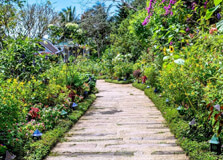
Sonya Garden is a serene and picturesque retreat nestled in the cool, lush hills of Tagaytay, Philippines. Known for its tranquil atmosphere, organic gardens, and exquisite rustic architecture, Sonya Garden has become one of the most sought-after destinations for relaxation, wellness, and fine dining in Tagaytay. Whether you're looking to escape the hustle and bustle of the city, indulge in a romantic getaway, or enjoy a family outing, Sonya Garden offers a perfect blend of nature, comfort, and charm. How to Reach Sonya Garden, Tagaytay, Philippines Sonya Garden is conveniently located along the Tagaytay-Nasugbu Highway, approximately 6 kilometers from the heart of Tagaytay. To get there, you can drive south from Metro Manila via the South Luzon Expressway (SLEX) and exit at Sta. Rosa. From there, follow the directions to Tagaytay, and then continue south along the Tagaytay-Nasugbu Highway. Sonya Garden is located on the right side of the road, marked with clear signage. The journey takes around 1.5 to 2 hours from Manila, depending on traffic conditions. If you're using public transportation, you can take a bus from Pasay or Buendia terminals in Manila that travels directly to Tagaytay. Once you arrive in Tagaytay, tricycles and jeepneys are available to take you to Sonya Garden, which is a short ride away from the main town. Weather at Sonya Garden, Tagaytay, Philippines Tagaytay enjoys a cool and refreshing climate due to its elevation of approximately 2,000 feet above sea level. The weather in the area is much cooler than in the lowlands of Metro Manila, making it a popular escape from the heat. The average temperature in Tagaytay ranges from 22°C to 30°C, with cooler temperatures in the evenings. The town has a tropical climate, with a distinct wet and dry season. The dry season typically lasts from December to May, while the rainy season is from June to November. The best time to visit Sonya Garden is during the dry season, as the weather is ideal for outdoor activities such as dining al fresco and enjoying the garden walks. However, if you prefer cooler weather, visiting during the rainy season can also offer a peaceful, less crowded experience. Why Sonya Garden, Tagaytay, Philippines is Famous Sonya Garden is famous for its peaceful and intimate ambiance, making it an ideal spot for relaxation, wellness retreats, and culinary experiences. The garden's signature features include its vast, well-maintained organic gardens, where visitors can stroll through lush greenery, vibrant flowers, and a variety of herbs and vegetables. The garden is also known for its Farm-to-Table dining experience, where guests enjoy freshly prepared meals using ingredients sourced from Sonya Garden’s own farm. Additionally, the retreat is famous for its wellness offerings, particularly its spa treatments. Sonya Garden’s spa services are centered on holistic well-being, offering massages, facials, and other therapeutic treatments designed to rejuvenate both the body and mind. The peaceful environment and focus on relaxation and wellness make it a favorite spot for those seeking a break from the stress of everyday life. Entry and Visit Details About Sonya Garden, Tagaytay, Philippines Sonya Garden operates as a bed-and-breakfast retreat, offering a combination of accommodations, dining, and wellness services. The garden is open to day visitors who want to experience the beauty of its surroundings, enjoy its dining offerings, or indulge in spa services. However, it is recommended to make reservations in advance, especially during weekends and holidays, as the place can get busy with local and international visitors. The entry fee to Sonya Garden is free for visitors who plan to dine or stay overnight. The primary cost for day visitors is for the Farm-to-Table meals offered in the garden, typically served as set meals or buffets. These meals range from PHP 500 to PHP 1,000 per person, depending on the type of meal. If you wish to avail of the spa services, they are offered at an additional cost, with prices starting at PHP 500 for simple treatments. History and Architecture of Sonya Garden, Tagaytay Sonya Garden was founded by Sonya and her husband, a couple who envisioned creating a sanctuary that would combine nature, wellness, and culinary arts. Over the years, the garden has developed into a destination for people seeking relaxation, healthy living, and a deeper connection with nature. Sonya’s vision was to build a retreat where people could escape the stresses of modern life, and that vision is reflected in the simple yet elegant rustic architecture of the property. The garden’s architecture features charming, cozy cottages, a rustic dining area, and a traditional spa pavilion, all blending seamlessly with the surrounding greenery. The main dining area, with its wooden beams, warm lighting, and open-air design, creates an inviting atmosphere that encourages guests to relax and savor their meals while enjoying the beauty of nature. Things to Do at Sonya Garden, Tagaytay, Philippines There is no shortage of things to do at Sonya Garden, whether you're looking for adventure, relaxation, or wellness. Here are some of the best activities to enjoy during your visit: Farm-to-Table Dining: Enjoy a delicious and healthy meal prepared using fresh, organic ingredients grown right on the property. The food at Sonya Garden is celebrated for its focus on natural flavors, often including homemade bread, salad, pasta, and their signature dishes like pansit, chicken, and homemade desserts. Spa Treatments: Take advantage of Sonya Garden’s relaxing spa services, including massages, facials, and other holistic treatments designed to rejuvenate the body and mind. Garden Walks: Stroll through the lush, organic gardens where you can admire the vibrant flowers, plants, and herbs grown on the property. The garden is a peaceful place to unwind and connect with nature. Photography: The picturesque surroundings of Sonya Garden make it a great place for photography, especially for nature lovers and those looking for a romantic backdrop for photos. Stay Overnight: If you wish to fully immerse yourself in the tranquil experience, consider staying overnight at one of the charming cottages on the property, offering a cozy and peaceful retreat. Interesting Facts About Sonya Garden, Tagaytay Sonya Garden is well-known for its organic gardening practices, where fresh fruits, vegetables, and herbs are grown on-site and used in meals prepared for guests. The garden offers a unique dining experience with a set menu that changes daily, featuring fresh, seasonal ingredients from the property’s farm. It’s a favorite destination for couples looking for a romantic retreat or for small weddings and private events, thanks to its peaceful atmosphere and beautiful setting. The garden is also a popular spot for wellness retreats, with its spa offering a variety of treatments aimed at promoting health and relaxation. Tips for Visiting Sonya Garden, Tagaytay Make a Reservation: Due to the popularity of Sonya Garden, especially on weekends, it’s best to make reservations in advance to secure your spot for dining or spa treatments. Arrive Early: To fully enjoy the garden and its amenities, it’s advisable to arrive early in the day to take in the beautiful surroundings and make the most of your visit. Bring Comfortable Shoes: The garden is perfect for walking, so wear comfortable footwear, especially if you plan on exploring the organic gardens. Check the Weather: Tagaytay's weather can be unpredictable, so check the forecast before your visit, especially if you're planning to spend time outdoors. Enjoy the Tranquility: Sonya Garden is all about relaxation, so take time to unwind, enjoy the peaceful atmosphere, and disconnect from the outside world.
Explore More
Kalibato Falls, nestled in the scenic province of Tagaytay, is one of the hidden gems of the region. Known for its refreshing natural beauty, this waterfall offers a peaceful retreat for nature lovers and adventure seekers alike. Despite being relatively unknown compared to other popular tourist spots in Tagaytay, Kalibato Falls has steadily gained attention for its serene environment, picturesque surroundings, and the chance to experience the raw beauty of nature in the area. The falls are particularly famous for their cool, clear waters and the lush green forest surrounding them, making it an ideal destination for those seeking tranquility away from the busy city life. How to Reach Kalibato Falls, Tagaytay, Philippines Kalibato Falls is located in the town of Silang, Cavite, which is about 6 kilometers from Tagaytay’s city center. While Tagaytay itself is easily accessible by car from Metro Manila via the South Luzon Expressway (SLEX) and the Tagaytay-Nasugbu Highway, getting to Kalibato Falls requires a bit more effort, as it is off the main road. To reach Kalibato Falls, take a jeepney, bus, or private vehicle to the town of Silang, Cavite. From Tagaytay, you will need to hire a tricycle or a local guide to take you to the falls. The road leading to the falls is a bit rough and may not be suitable for regular vehicles, so it’s advisable to go with a local guide or hire a tricycle that is used to traveling these routes. The entire journey from Tagaytay to Kalibato Falls takes about 20-30 minutes, depending on the condition of the road and traffic. Weather at Kalibato Falls, Tagaytay, Philippines Tagaytay and the surrounding areas, including Kalibato Falls, are known for their cooler and more comfortable climate compared to the rest of the country. The average temperature in Tagaytay ranges from 22°C to 30°C, making it an excellent escape from the tropical heat of Metro Manila. Since Kalibato Falls is located in a forested area, you can expect the temperature to be even cooler, especially near the waterfall itself. The weather in Tagaytay and Silang is divided into two seasons: the dry season (from December to May) and the wet season (from June to November). The dry season is generally the best time to visit Kalibato Falls, as the trail and surrounding areas are easier to navigate without the risk of flooding. During the rainy season, the waterfall becomes even more powerful, but the path can become slippery and muddy, which can make the trek challenging. Why Kalibato Falls, Tagaytay, Philippines is Famous Kalibato Falls is gaining popularity because of its unspoiled beauty and peaceful environment. Unlike the more commercialized tourist spots in Tagaytay, Kalibato Falls offers a more intimate and rustic experience. It is famous for its crystal-clear waters, cool ambiance, and the opportunity to enjoy nature at its finest. The waterfall cascades down into a natural pool, inviting visitors to take a refreshing dip in its cool waters. Moreover, Kalibato Falls is known for its serene and less crowded atmosphere. This makes it an ideal location for those who wish to escape the hustle and bustle of city life and immerse themselves in the calmness of nature. The waterfall is also surrounded by dense vegetation, making it a great spot for photography, hiking, and even picnics with friends and family. Entry and Visit Details About Kalibato Falls, Tagaytay, Philippines Kalibato Falls is open to the public year-round, but it’s essential to note that the accessibility of the area depends on the weather, especially during the rainy season. Visitors can access the falls by paying a small entry fee that typically ranges from PHP 30 to PHP 50 per person, depending on the season and local management. It is highly recommended to visit with a local guide or hire a tricycle for safe and smooth travel to the falls, as the road leading to the falls can be quite rough and difficult to navigate without a local expert. The best time to visit Kalibato Falls is early in the morning or late in the afternoon. Visiting early allows you to enjoy the falls while the weather is still cool and before it gets crowded. Late afternoon is another great option, as the area is relatively quiet and the light is perfect for photography. The waterfall is most picturesque when the sun is lower in the sky, casting a soft glow over the landscape. History and Architecture of Kalibato Falls Kalibato Falls does not have a long history in the sense of being a historical landmark or monument. However, it is a natural treasure that has been appreciated by locals and travelers alike for many years. The name “Kalibato” is derived from a local term that roughly translates to “place of abundance,” reflecting the lush vegetation and abundant natural beauty surrounding the falls. Over time, the falls have become a beloved spot for locals, who take pride in preserving its natural state. The architecture of the falls is, of course, nature itself. Kalibato Falls is surrounded by dense forest, with large trees providing shade to the area. The waterfalls themselves are framed by rocks and natural formations, creating a picturesque scene for anyone who visits. There are no man-made structures around the falls, and this is one of the things that makes the location so special—it remains untouched and unspoiled by commercialization. Things to Do at Kalibato Falls, Tagaytay, Philippines There are several activities you can enjoy when visiting Kalibato Falls, including: Swimming: The natural pool beneath the falls is perfect for a refreshing swim. The cool, clear waters offer a relaxing experience, especially after a short hike to the falls. Hiking: The trail to Kalibato Falls is a relatively easy hike, making it accessible for most visitors. The path is surrounded by lush greenery, and the sound of the waterfall guides you as you approach the falls. Picnicking: The area around Kalibato Falls is peaceful and perfect for a picnic. You can bring your own food and enjoy a meal surrounded by nature. Photography: The falls and the surrounding landscape make for an ideal photography destination. Whether you're an amateur or a professional photographer, Kalibato Falls offers plenty of opportunities to capture stunning shots. Nature Walks: The area surrounding the falls is rich with flora and fauna, and nature lovers can enjoy a peaceful walk to explore the local vegetation and wildlife. Interesting Facts About Kalibato Falls, Tagaytay The falls are less commercialized compared to other famous waterfalls in the Philippines, which makes it a more peaceful and intimate destination. Kalibato Falls is a popular spot for both locals and tourists, and it’s an excellent destination for those looking to escape the noise of city life. The surrounding area is home to various types of wildlife, including birds and small mammals, making it a great spot for nature watching. Although the falls are not as well-known as other spots, they are gaining attention due to their scenic beauty and accessibility from Tagaytay. Tips for Visiting Kalibato Falls, Tagaytay Bring Water and Snacks: There are no commercial food stalls near the falls, so it’s a good idea to bring your own snacks and plenty of water, especially if you plan to hike and spend a few hours in the area. Wear Comfortable Clothing and Shoes: Since there is a short hike to reach the falls, wear comfortable shoes and clothing that you don’t mind getting wet. Check the Weather Forecast: It’s advisable to visit during the dry season (December to May) to ensure the path to the falls is easily accessible and the experience is enjoyable. Respect the Environment: Since Kalibato Falls is a natural site, make sure to leave no trace behind. Clean up after yourself and avoid littering in the area. Hire a Local Guide: For a more informative and safe visit, consider hiring a local guide who can help you navigate the trail and provide insights about the area.
Explore MorePhilippines - The Heart Of History - Culture 9 Days 8 Nights Tour
9 Days/ 8 Night
Cebu - Manila - Palawan
Philippines Island Adventure - 10 Days Tour
10 Days/ 9 Night
Cebu - Manila - Palawan
6Nights Philippines - Cebu - Bohol - Manila Tour
7 Days/ 6 Night
Cebu - Manila - Bohol
Cebu - Bohol Discovery 5 Days
5 Days/ 4 Night
Cebu - Visayas - Bohol
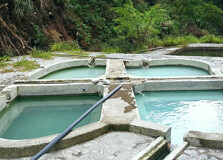
Ducligan Hot Spring sprawls in Banaue, Ifugao. It can be found on the coasts of Ducligan River situated near to a deep pool. Ducligan can be reached from Poblacion by covering a distance of 21 kilometers. One can reach Ducligan Hot Spring within an hour and a half drive and twenty minute walk to reach the hot spring spot. Visitors can take a retreat over here to enjoy warm baths during cold weather. Ducligan Hot Spring also features swimming pool, hot tubs, toilets and various other amenities.
Explore More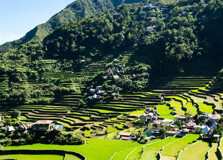
Also referred as “Eighth Wonder of the World”, Banaue Rice Terraces are two thousand year old terraces frequented by visitors throughout the year. Contrived into the mountains of Ifugao in the Philippines, these are known to be built with hands. Local guides can also be hired easily for exploring the terraces. Opportunity to Explore Ifugao Rice CultureBanaue Rice Terraces straddle in Ifugao province, and are managed by the natives. Ifugao culture is linked to its rice cultivation practices and sundry of celebrations associated with agricultural rites. During ones visit to terraces, one can explore the Ifugao rice culture overwhelmingly! Various Activities· Visitors can indulge in sightseeing activities and enjoy beautiful views of terraces .· They can make visits to the tribe communities residing at the terraces’ foot.· One can also pay visit to Mumbakis, traditional Ifugao witch doctors. These doctors are known for performing spiritual healing rituals. Clusters Inscribed as Part of Rice TerracesBanaue Rice Terraces are not acclaimed as a UNESCO World Heritage Site. There are five clusters that have been inscribed as part of the Philippine Cordilleras and these are Mayoyao Central, Batad, Nagacadan, Hungduan and Bangaan. Ifugao rice terraces including Banaue Rice Terraces were declared to have no genetically modified organisms (GMO) in March 2009.
Explore More
Located in Banaue, Tappiyah Waterfalls are flocked by swarming number of travelers throughout the year. The crystal clear water falls from the top and a beautiful pool is formed below. The area surrounding the pool is pea green and there are also many beautiful rocks slumped there. During ones visit to the waterfalls, one can also explore the rice terraces here and which are counted amongst the wonders of the world. How to Reach?· It can be reached via a 30-min. to 1-hr. hike from Brgy.· Batad Village is situated near to the waterfalls and one would only have to cover a thirty minutes distance to reach the waterfalls from the village. GuidesOne can hire local guides by paying a very nominal fee. The local guides make the travelers explore the region right from the beginning to end of locales. What to Do Here?· One can enjoy activities like swimming in the enormous natural pool.· One can spend time amidst the verdant mountains strolling or taking naps.· One can explore the rich flora and marine fauna. · In the regions near to waterfall, one can explore the old Philippines culture. One should not miss visiting Tappiyah Waterfalls during ones trip to Banaue.
Explore More
Mount Luho is deemed to be the highest point in Boracay. The mountain is known to have a splendid viewing tower and walkway. Many visitors make visit to the mountain to see the beautiful sunrise and sunset. At the time when the sun is rising, there are not many people on the mountain. If one wishes to make visit when other visitors are also there, one must make visit to the mountain in the evening. Things to Do · Visitors can enjoy views of Bolabog Beach, the Fairways and Bluewaters Golf Course and the ocean from the mountain. · Travelers can also include visit to the park with a zip line in their itinerary. · There is a small zoo, which is haven to birds and animals including Philippine Eagles, snakes and monkeys, and which can be visited. How to Reach? · One can choose to reach the mountain from Bolabog Beach (north end). But many do not prefer to do so as the road is steep and people with good body condition can only choose to walk all the way upwards. · One can also reach the mountain via mountain bike. The ride can be taken from the back side. A tricycle can also be hired on rent easily. One can negotiate the rent too. Renting the vehicle usually costs between 150 to 300 pesos. One can follow the main road and it would only take thirty minutes to reach the mountain.
Explore More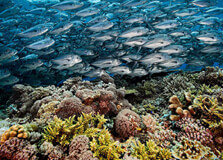
Tubbataha Reefs Natural Park is a UNESCO World Heritage Site located in the middle of the Sulu Sea, about 150 kilometers southeast of Puerto Princesa City in Palawan, Philippines. It is one of the most pristine marine ecosystems in the world and is considered the crown jewel of Philippine diving destinations. Covering nearly 97,000 hectares of protected marine area, Tubbataha is home to an extraordinary diversity of marine species, including over 600 species of fish, 360 species of corals, sea turtles, sharks, and seabirds. The park consists of two massive atolls—the North and South Atolls—and the smaller Jessie Beazley Reef, surrounded by deep ocean waters that sustain its incredible biodiversity. How to reach Tubbataha Reefs Natural Park The only way to reach Tubbataha Reefs is by liveaboard dive boats that depart from Puerto Princesa. The journey typically takes 10 to 12 hours of sailing through the open Sulu Sea. Due to its remote location, there are no permanent settlements or commercial facilities on the reefs. The liveaboard vessels serve as both transport and accommodation for divers and visitors. Flights to Puerto Princesa are available from Manila, Cebu, and other major Philippine cities. Once in Puerto Princesa, travelers board their liveaboard ships from the port. Trips are seasonal, running only from mid-March to mid-June when sea conditions are calm and visibility is at its best. Booking should be made months in advance since the number of vessels and slots is strictly limited for conservation reasons. Weather The best weather for visiting Tubbataha Reefs is during the dry season, specifically from March to June. During this period, the sea is calm, skies are clear, and underwater visibility can exceed 40 meters—ideal conditions for diving and photography. The rest of the year, especially from July to February, strong winds and rough seas make the park inaccessible. Water temperatures range from 27°C to 30°C throughout the year, offering comfortable conditions for divers. Always check weather forecasts before embarking, as trips are dependent on sea conditions. Timing Tubbataha Reefs Natural Park is open to visitors only during its diving season from mid-March to mid-June. Each liveaboard trip lasts between 5 to 7 days, depending on the itinerary. Because of its remote location, day trips are not possible. The park’s management limits visitor numbers to ensure the reef’s protection and sustainability, so early planning and reservations are essential. Why Tubbataha Reefs Natural Park is famous Tubbataha is globally famous as one of the top diving sites in the world. It is celebrated for its exceptionally rich marine biodiversity, untouched coral reefs, and high ecological integrity. Divers from around the world come to witness its pristine underwater landscapes, abundant marine life, and dramatic drop-offs that plunge over 100 meters deep. The area’s protection status, established since 1988, has kept it free from destructive human activities, allowing it to thrive as a sanctuary for endangered species like hawksbill turtles, manta rays, and various shark species. Its isolation has preserved its natural beauty, making it a true underwater paradise. Entry and visit details All visits to Tubbataha are highly regulated. The following details are important for visitors: Permits: Entry is allowed only through accredited liveaboard operators authorized by the Tubbataha Management Office (TMO). Each visitor pays a marine park conservation fee used for maintenance and protection. Stay duration: Most trips last 5–7 days, offering multiple dives per day across different sites. Safety: Because of its remote location, operators adhere to strict safety standards, and medical support is available onboard. Divers must have open-water certification or higher due to the depth and currents. Accommodation and food: Provided onboard the liveaboard vessels, which include cabins, dining areas, and dive decks. History & architecture Tubbataha’s name originates from the Samal language, meaning “a long reef exposed at low tide.” Historically, the reefs were known to local fishermen and seafarers but remained largely untouched due to their remote location. In 1988, Tubbataha Reefs National Marine Park was established to protect its ecosystem from illegal fishing. It was declared a UNESCO World Heritage Site in 1993 and later expanded and renamed Tubbataha Reefs Natural Park in 2009. There are no architectural structures within the park except for the ranger station built on the North Atoll, which serves as the base for marine rangers and researchers who monitor and protect the area year-round. The station is a symbol of conservation success in the Philippines. Things to do Tubbataha is primarily a diving destination, offering some of the most extraordinary underwater experiences in the world. Here are the top activities: Scuba Diving: Explore coral-covered walls, dramatic drop-offs, and pelagic encounters with sharks, rays, and schools of barracuda. Underwater Photography: Capture the vibrant coral reefs, sea turtles, and diverse fish species in crystal-clear visibility. Marine Life Observation: Spot manta rays, whale sharks, hammerheads, and rare reef fish in their natural habitat. Birdwatching: Observe seabirds like the red-footed booby and sooty tern nesting on the islets. Educational Tours: Learn from marine park rangers about the conservation efforts and biodiversity monitoring projects. Facts • Tubbataha Reefs cover nearly 100,000 hectares of protected marine space. • It is part of the Coral Triangle, known as the world’s center of marine biodiversity. • Over 360 coral species (almost 90% of Philippine coral types) and more than 600 fish species have been recorded. • It serves as a breeding ground for marine turtles, sharks, and seabirds. • The park is patrolled year-round by rangers to prevent illegal fishing and maintain reef integrity. Tips Here are some useful tips for visiting Tubbataha Reefs Natural Park: Book early—liveaboard trips fill up fast, often a year in advance. Ensure you have proper dive certification and insurance covering diving activities. Pack light but bring reef-safe sunscreen, underwater cameras, and essential medications. Respect all conservation rules—do not touch corals or disturb marine life. Support sustainable tourism by choosing accredited and eco-conscious operators. Bring cash for park fees, as card facilities are unavailable once aboard. Final note: Visiting Tubbataha Reefs Natural Park is a once-in-a-lifetime experience that immerses travelers in the purest form of marine wilderness. Its remote location, pristine waters, and remarkable biodiversity make it a global treasure and a shining example of marine conservation success in the Philippines.
Explore More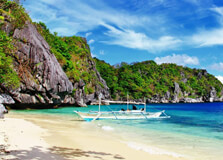
Sabang Beach is one of the most stunning coastal destinations in Puerto Princesa, Palawan. Known for its long stretch of golden sand, clear turquoise waters, and serene atmosphere, Sabang Beach serves as the main gateway to the world-famous Puerto Princesa Underground River. Nestled between lush mountains and the West Philippine Sea, this tropical paradise offers a blend of natural beauty, tranquility, and adventure. It’s the perfect escape for travelers seeking a peaceful retreat while staying close to one of the most iconic natural wonders of the Philippines. How to Reach Sabang Beach Sabang Beach is located about 80 kilometers north of Puerto Princesa City and takes around two hours to reach by land. Visitors can hire a private van, join a guided tour, or take a public bus or shuttle from the San Jose Terminal in Puerto Princesa. The scenic drive to Sabang passes through beautiful countryside, rolling hills, and coastal views. If you book an Underground River tour package, transportation to Sabang is typically included. Once in the village, the beach is just a short walk from the pier where boats depart for the Underground River. Weather in Sabang Beach Sabang Beach enjoys a tropical climate throughout the year, with warm temperatures and refreshing sea breezes. The best time to visit is during the dry season from November to May, when the sea is calm and the skies are clear. Average temperatures range from 26°C to 33°C, perfect for swimming and beach activities. During the rainy season (June to October), occasional showers can occur, but mornings are often sunny and ideal for sightseeing. Visitors should bring sunscreen, hats, and light clothing to stay comfortable under the tropical sun. Timing Sabang Beach is open to visitors year-round, and there are no specific operating hours. However, most activities, such as swimming, boating, and island tours, are available during daylight hours, typically from 6:00 AM to 6:00 PM. Early mornings are perfect for quiet walks and sunrise views, while late afternoons offer breathtaking sunsets over the West Philippine Sea. Visitors staying overnight in beachfront resorts can enjoy the calm evening ambiance and stargazing by the shore. Why Famous for Sabang Beach, Puerto Princesa Sabang Beach is famous for being the jumping-off point to the Puerto Princesa Subterranean River National Park, a UNESCO World Heritage Site and one of the New 7 Wonders of Nature. Apart from its proximity to this world-renowned attraction, Sabang Beach is celebrated for its raw natural beauty, unspoiled coastline, and peaceful environment. Unlike crowded commercial beaches, Sabang retains a laid-back charm where visitors can relax, unwind, and enjoy nature. The beach’s picturesque setting, framed by mountains and palm trees, makes it a favorite destination for photographers and nature lovers. Entry and Visit Details about Sabang Beach, Puerto Princesa There is no entrance fee to access Sabang Beach, making it a free and open destination for everyone. Visitors can walk along the beach, swim in the calm waters, or simply relax on the sand. Several resorts and cottages line the coast, offering food, drinks, and accommodations for those wishing to stay overnight. The beach is also the boarding point for Underground River tours, so visitors can conveniently explore both attractions in one trip. Basic amenities such as restrooms, showers, and small shops are available near the beach area. Local vendors also sell souvenirs and refreshments to visitors. History and Architecture Sabang Beach was once a quiet fishing village before it gained recognition as the access point to the Puerto Princesa Underground River. Over the years, as tourism in Palawan grew, the area developed into a small eco-friendly resort town while maintaining its natural charm. The beach and its surroundings feature native-style accommodations made of bamboo, nipa, and wood — blending harmoniously with the environment. Most establishments follow eco-tourism principles, using sustainable materials and practices to protect the area’s pristine condition. Despite its growing popularity, Sabang has preserved its authentic rural atmosphere and natural beauty. Things to Do at Sabang Beach There are many exciting and relaxing activities to enjoy at Sabang Beach for all types of travelers: Swimming and Sunbathing: Enjoy the warm, calm waters and golden sands of the beach. Underground River Tour: Take a boat trip to the world-famous Puerto Princesa Subterranean River. Sabang X Zipline: Experience an adrenaline rush as you glide 800 meters over the sea with a panoramic view of the beach and mountains. Boat Rides: Join short coastal boat tours to explore nearby coves and rock formations. Snorkeling and Diving: Discover vibrant marine life near the reef areas around Sabang. Hiking and Nature Trails: Explore forest paths leading to waterfalls and viewpoints near the village. Dining by the Sea: Enjoy fresh seafood and Filipino dishes in beachfront restaurants and small eateries. Relaxation: Unwind in hammocks or lounge chairs under palm trees, listening to the sound of the waves. Facts about Sabang Beach Sabang Beach is the main entry point to the Puerto Princesa Underground River, a UNESCO World Heritage Site. The beach stretches for several kilometers, providing plenty of space for visitors to explore. It is located in a small village surrounded by mountains and rainforest, adding to its scenic beauty. Sabang Beach is one of the few places in Palawan where you can enjoy both mountain and sea views at once. Local residents continue to fish and farm, maintaining the traditional lifestyle despite tourism growth. Tips for Visiting Sabang Beach Visit early in the morning to enjoy calm seas and fewer crowds. Bring cash, as ATMs may not be available in the village. Book accommodation or Underground River tours in advance, especially during peak season. Wear sunscreen, a hat, and light clothing to protect yourself from the sun. Respect the environment — dispose of trash properly and avoid disturbing wildlife. Stay overnight to experience the tranquil atmosphere after day-tour visitors leave. Don’t miss the stunning sunset view over the West Philippine Sea.
Explore More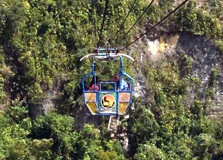
Danao Adventure Park, located in the municipality of Danao in Bohol, Philippines, is one of the top destinations in the country for eco-adventure and extreme outdoor sports. Surrounded by lush mountains, deep gorges, and the scenic Wahig River, the park offers an exciting blend of nature, thrill, and sustainable tourism. It is part of the E.A.T. Danao (Extreme, Adventure, and Tour) project initiated by the local government to promote tourism while preserving the natural environment. The park is best known for its heart-pounding zip line, plunge, caving, rappelling, kayaking, and other adrenaline-pumping activities that attract both local and international visitors. How to reach Danao Adventure Park, Bohol Danao Adventure Park is located about 72 kilometers north of Tagbilaran City, the capital of Bohol. Traveling from Tagbilaran takes around two to three hours by car or van. Visitors can rent a private vehicle, join organized tours, or take a public bus bound for Danao from the Dao Integrated Bus Terminal in Tagbilaran City. From the Danao town proper, local habal-habal (motorbike taxis) or tricycles can take you directly to the park entrance. For visitors coming from Panglao Island or Bohol–Panglao International Airport, the most convenient route is via Tagbilaran City, where you can arrange transport through travel agencies or rental services. Although the drive may be long, it offers scenic views of Bohol’s countryside, rice terraces, and local villages along the way. Weather and best time to visit Bohol enjoys a tropical climate, making Danao Adventure Park accessible year-round. However, the best time to visit is during the dry season, which typically runs from November to April. During these months, the trails, cliffs, and outdoor areas are dry and ideal for adventure activities. The rainy season (May to October) can make some attractions temporarily unavailable or more challenging due to slippery conditions. For cooler weather and clearer views, visit early in the morning or during the late afternoon. Opening hours and timing Danao Adventure Park usually operates daily from 8:00 AM to 5:00 PM. It’s advisable to arrive early to enjoy a full day of activities, as some adventures require orientation and safety briefings. The park can get crowded during weekends and holidays, so weekday visits are recommended for a more relaxed experience. Certain activities such as caving and river trekking may have specific cut-off times, so it’s best to confirm schedules in advance through the park’s official website or local tourism office. Why Danao Adventure Park, Bohol, is famous Danao Adventure Park is famous for its world-class extreme adventure activities set amid stunning natural landscapes. Its signature attraction is “The Plunge,” a canyon swing that drops adventurers 200 meters above the Wahig River gorge — one of the highest and most thrilling rides in the Philippines. The park’s long zip line, known as the “Suwaki Zip,” lets visitors soar across deep valleys while enjoying panoramic views of the forest and river below. Other popular attractions include rappelling, river kayaking, bungee jumping, caving, and mountain trekking. Beyond thrill-seeking, the park is known for its sustainable tourism practices. It is a community-based project that provides employment and livelihood opportunities to locals, all while protecting the environment and promoting eco-friendly tourism development in Bohol. Entry and visit details Visitors must register at the main entrance and pay a small environmental and admission fee. Each activity has its own individual rate, and packages are available for tourists who want to experience multiple adventures in one visit. Trained guides and instructors are always present to ensure safety. All participants are required to wear safety gear, attend short orientations, and sign waivers before joining extreme activities. The park also features picnic areas, view decks, restrooms, and a restaurant offering local Filipino cuisine. For those who wish to stay overnight, there are eco-lodges and camping facilities inside the park and nearby homestays in Danao town. Advanced booking is recommended, especially during weekends and holidays. History and background Danao Adventure Park was established in 2006 as part of a community-based eco-tourism project spearheaded by the local government of Danao. Its goal was to create a sustainable tourism model that benefits residents while preserving the natural beauty of the Wahig River Valley. The project was inspired by the town’s historical significance — Danao was once a stronghold of Francisco Dagohoy, a Filipino revolutionary leader who led the longest rebellion against Spanish rule in Philippine history. The park’s creation aimed to blend adventure tourism with environmental awareness and cultural preservation. The park’s design and infrastructure reflect eco-friendly principles. Simple wooden platforms, rope bridges, and natural trails blend harmoniously with the landscape. Facilities were constructed with minimal disturbance to the environment, ensuring that visitors experience adventure while being surrounded by pristine nature. Things to do at Danao Adventure Park • The Plunge: Experience an exhilarating canyon swing that drops you hundreds of meters into the gorge — the park’s most famous attraction. • Zipline: Glide across a 500-meter zipline with breathtaking views of the forest and river below. • Rappelling and Caving: Explore the rugged terrain through vertical descents and underground cave systems like Kamira Cave. • Kayaking and River Trekking: Navigate the Wahig River’s rapids or enjoy a peaceful paddle through calm sections. • Root Climbing and Wall Climbing: Challenge your strength and agility with tree and wall climbing adventures. • ATV and Mountain Biking: Ride through scenic trails and forest roads for a more laid-back exploration. • Camping and Nature Trails: Stay overnight and experience the tranquility of nature while stargazing and listening to the forest at night. Facts about Danao Adventure Park • The park sits on a natural gorge system carved by the Wahig River. • “The Plunge” is one of Asia’s highest canyon swings at about 200 meters deep. • The park was developed under the E.A.T. Danao initiative to promote eco-adventure tourism. • Danao is historically linked to the Dagohoy Rebellion, which lasted more than 80 years (1744–1829). • It is one of the few adventure parks in the Philippines managed by a local government unit, ensuring profits go back to community projects. Tips for visitors • Arrive early to maximize your time and avoid waiting in line for activities. • Wear comfortable clothing suitable for physical activity and bring a change of clothes. • Apply sunscreen, wear closed shoes, and bring insect repellent. • Bring extra cash, as some areas have limited mobile signal and card payment options. • Follow all safety instructions from guides, especially for high-risk activities. • If you plan to try multiple adventures, book package deals to save money. • Respect the environment — avoid littering and follow eco-tourism rules. Final notes Danao Adventure Park is a perfect destination for travelers seeking both excitement and environmental awareness. It combines thrilling adventure, breathtaking scenery, and local culture in one unforgettable experience. Whether you are ziplining across a canyon, exploring ancient caves, or learning about Bohol’s revolutionary past, Danao Adventure Park guarantees a day filled with adventure and inspiration. It’s not just a destination — it’s an adventure that celebrates the best of Bohol’s natural and cultural heritage.
Explore More
Hinagdanan Cave, located in Dauis on Panglao Island in Bohol, Philippines, is a stunning natural formation known for its remarkable limestone features and crystal-clear freshwater pool. This underground cave has become one of Bohol’s most popular tourist spots, offering visitors a chance to explore its serene chambers, swim in its cool waters, and admire the fascinating stalactites and stalagmites formed over thousands of years. Whether you're a nature enthusiast, photographer, or just seeking a peaceful getaway, Hinagdanan Cave provides a captivating experience. How to Reach Hinagdanan Cave, Bohol Hinagdanan Cave is situated approximately 20 kilometers from Tagbilaran City, the capital of Bohol. From Tagbilaran, visitors can take a taxi, tricycle, or private vehicle for the 30-minute drive to the cave. If you’re arriving at Panglao International Airport, you can reach the cave in just 25 minutes by car. Public transport such as jeepneys and buses operates between Tagbilaran and Panglao, but hiring a private vehicle or taking a taxi is the most convenient option for visitors. The cave is close to popular tourist spots such as Alona Beach and the Tarsier Sanctuary, making it easy to combine visits to multiple attractions in a single day. Weather and Best Time to Visit Bohol enjoys a tropical climate with a dry season from November to April and a wet season from May to October. The best time to visit Hinagdanan Cave is during the dry season, when the weather is sunny and the cave’s interior remains cool and clear for swimming and photography. The wet season may bring rain, and the roads leading to the cave can become slippery. Early mornings and late afternoons also offer more tranquil visits, with fewer tourists and beautiful lighting for photos. Opening Hours and Timing Hinagdanan Cave is open daily from 8:00 AM to 5:00 PM. To enjoy a more peaceful experience and avoid crowds, it is recommended to visit early in the morning or late in the afternoon. These times also provide the best lighting conditions, as sunlight filters through the cave’s openings and creates magical reflections on the water below. It’s important to note that the cave can get busier during peak tourist seasons, so planning your visit during off-peak hours is ideal. Why Hinagdanan Cave, Bohol, is Famous Hinagdanan Cave is famous for its stunning natural beauty and fascinating geological formations. It is one of the few caves in the Philippines that is open to the public for exploration and swimming. The cave’s crystal-clear freshwater pool, surrounded by impressive stalactites and stalagmites, is one of its main attractions. The cave’s accessible location, close to other Bohol landmarks, also contributes to its popularity among tourists. The cave has gained fame as a prime destination for nature lovers and adventure seekers who want to explore the underground world while enjoying the serenity of the environment. Its easy accessibility and beautiful surroundings make it one of the must-visit sites in Bohol. Entry and Visit Details The entrance fee to Hinagdanan Cave is typically around PHP 50 to PHP 100, depending on the time of visit. This fee helps support the maintenance and preservation of the site. Visitors can explore the cave independently or hire a local guide who can provide detailed information about the cave’s history, geological features, and cultural significance. Inside the cave, visitors can swim in the cool, clear water, but it is important to adhere to safety guidelines to preserve the cave’s natural features. Water shoes or comfortable footwear are recommended, as the cave’s floor can be slippery, especially near the water. The site also has basic amenities such as restrooms and a small souvenir shop selling local crafts and products. History and Architecture of Hinagdanan Cave Hinagdanan Cave’s history dates back centuries, with locals using it as a natural water source long before it became a tourist destination. The cave’s name, “Hinagdanan,” refers to the stone steps (hagdan) that were built by the locals to allow easy access into the cave. The cave was eventually developed for tourism, and the steps were preserved to maintain access for visitors. Geologically, the cave is a marvel, formed over millions of years by the deposition of minerals carried by water that dripped through the limestone. The stalactites and stalagmites inside are continuously growing, making the cave an active geological site. The cave’s interior is cool and dark, offering a peaceful escape from the heat of the outside world. Things to Do at Hinagdanan Cave • Swimming: Enjoy swimming in the freshwater pool inside the cave, which is perfect for cooling off on a hot day. • Photography: The cave’s rock formations and the shimmering water offer excellent opportunities for taking beautiful photos. • Exploration: Wander through the cave’s chambers to admire the impressive stalactites and stalagmites. • Picnicking: Have a picnic at the entrance to the cave, surrounded by lush greenery and the tranquil sounds of nature. • Guided Tours: Hire a local guide to learn more about the cave’s history, formation, and cultural significance. Facts about Hinagdanan Cave • The cave is about 25 meters deep and has several chambers, one of which contains the freshwater pool. • It is one of the few caves in the Philippines that allows swimming inside. • The stalactites and stalagmites inside the cave are still growing, as the cave remains an active geological feature. • The freshwater pool inside the cave is formed by an underground spring that flows into the cave. • Hinagdanan Cave is located near other Bohol landmarks, such as Alona Beach and the Tarsier Sanctuary. Tips for Visitors • Wear comfortable, non-slip shoes as the cave floor can be slippery. • Bring swimwear if you plan to swim in the freshwater pool. • Avoid touching the stalactites and stalagmites to help preserve the cave. • If you plan to take photos, consider using a waterproof camera or phone. • Visit early or late in the day to avoid the crowds and enjoy a more peaceful experience. • Check the weather before visiting, as heavy rains can make travel to the cave more difficult.
Explore More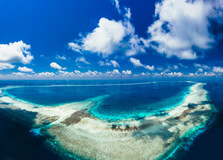
Tubbataha Reefs Natural Park is one of the most incredible marine sanctuaries in the world and a UNESCO World Heritage Site. Located in the middle of the Sulu Sea, about 150 kilometers southeast of Puerto Princesa City in Palawan, this protected area is a haven for marine biodiversity. It is composed of two huge atolls—the North and South Atolls—and the smaller Jessie Beazley Reef. This natural park covers around 97,000 hectares of pristine coral reefs, crystal-clear waters, and a rich marine ecosystem that supports thousands of species of fish, corals, and other sea life. Tubbataha is recognized as one of the best diving destinations in the world, attracting divers from across the globe who come to witness its vibrant underwater beauty, diverse marine life, and unspoiled natural environment. How to Reach Tubbataha Reefs Natural Park Reaching Tubbataha Reefs Natural Park requires some planning since it is located in the open sea and is accessible only by liveaboard dive boats. The journey typically starts in Puerto Princesa City, the capital of Palawan. From Puerto Princesa, travelers board a liveaboard dive vessel that sails overnight to the reefs. The voyage takes approximately 10 to 12 hours, depending on sea conditions. There are no commercial ferry services to the park—only authorized dive operators with government-approved permits are allowed to bring visitors to Tubbataha. The liveaboard boats are fully equipped with diving facilities, accommodation, and meals, providing visitors with a comfortable and exciting adventure on the sea. These trips usually last between 5 to 7 days, giving divers ample time to explore different dive sites within the park. Weather and Best Time to Visit The Tubbataha Reefs are located in a region with a tropical climate. The best time to visit is from mid-March to mid-June, when the sea is calm, visibility is at its best (up to 40 meters), and weather conditions are ideal for diving. During these months, the northeast monsoon has ended, and the southwest monsoon has not yet begun, creating a perfect window for safe and enjoyable travel to the reefs. Outside this period, the seas are often rough and unpredictable due to monsoon winds, making it unsafe for boats to travel to the area. The park is closed to tourists from mid-June until mid-March every year to protect the marine environment and allow wildlife to thrive undisturbed. Timing and Operating Details Tubbataha Reefs Natural Park is open to visitors only during its diving season—from mid-March to mid-June. Within this period, diving expeditions operate daily, with each liveaboard trip lasting several days. There are no fixed operating hours since the park is in open waters, but most dives are conducted during daylight hours, with occasional night dives allowed in specific zones. All tours are managed under the supervision of the Tubbataha Management Office (TMO) and the Department of Environment and Natural Resources (DENR) to ensure sustainable practices and environmental protection. Why Tubbataha Reefs Natural Park is Famous Tubbataha Reefs Natural Park is world-famous for its incredible marine biodiversity and breathtaking underwater landscapes. It is home to nearly 600 species of fish, 360 species of corals (about half of all coral species found globally), 11 species of sharks, 13 dolphin and whale species, and numerous seabirds and sea turtles. The park’s reefs are among the most well-preserved in the Philippines due to its isolation and strict conservation measures. It has been declared both a UNESCO World Heritage Site (1993) and a Ramsar Wetland of International Importance (1999). Divers and nature lovers consider Tubbataha a “living aquarium,” offering unforgettable underwater encounters with manta rays, whale sharks, hammerhead sharks, and vibrant schools of tropical fish. Its pristine condition and ecological importance make it a symbol of successful marine conservation. Entry and Visit Details Visitors to Tubbataha must join authorized liveaboard tours that have government permits. Independent travel is not allowed to protect the park’s delicate ecosystem. Tour prices vary depending on the operator, boat type, and duration, but typically range from USD 1,000 to 2,500 for a 5- to 7-day trip, including accommodation, meals, and multiple dives per day. An environmental fee (usually around PHP 3,000 per person) is collected from each visitor to support park management and conservation. All visitors are required to follow strict diving regulations to avoid damaging corals or disturbing marine life. History and Conservation Tubbataha was first discovered by fishermen who used the reefs as a rest stop during their sea journeys. In the 1970s, divers began to explore its underwater beauty, bringing global attention to its ecological significance. In 1988, the Philippine government declared the area as the Tubbataha Reefs National Marine Park, recognizing the need to protect it from destructive fishing and illegal poaching. Later, it was renamed the Tubbataha Reefs Natural Park and placed under the protection of UNESCO. Since then, it has become a model for marine conservation, supported by local communities and environmental organizations. Things to Do at Tubbataha Reefs Natural Park • Scuba Diving: Explore some of the world’s best dive sites featuring colorful corals, sharks, manta rays, and turtles. • Underwater Photography: Capture stunning photos of coral gardens and marine species in crystal-clear visibility. • Bird Watching: Visit the small islets that serve as nesting grounds for seabirds like boobies and terns. • Marine Education: Learn about coral ecosystems, marine biodiversity, and conservation efforts through dive briefings and lectures onboard. • Stargazing: Enjoy breathtaking night skies from the liveaboard vessel, far from city lights. Facts about Tubbataha Reefs Natural Park • Tubbataha covers about 97,030 hectares of protected marine area. • It consists of two main atolls: the North and South Atolls, plus the Jessie Beazley Reef. • It hosts around 600 fish species and 360 coral species—almost half of all coral species on Earth. • Whale sharks and hammerhead sharks are often sighted during the diving season. • The park was declared a UNESCO World Heritage Site in 1993. • Fishing, anchoring, and coral collection are strictly prohibited. Tips for Visitors • Book liveaboard trips at least six months in advance as slots are limited. • Ensure you have sufficient diving experience (advanced open water certification is recommended). • Bring underwater cameras and eco-friendly sunscreen. • Respect park regulations and avoid touching corals or marine animals. • Pack light and include seasickness medication, as the voyage can be long. • Stay hydrated and enjoy every dive responsibly.
Explore More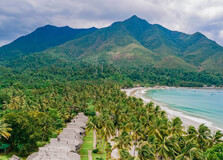
Sabang Beach, Palawan, Philippines Sabang Beach is a stunning stretch of coastline located in Puerto Princesa, Palawan, Philippines. Known for its natural charm, golden sand, and clear turquoise waters, it serves as the gateway to the world-famous Puerto Princesa Underground River, a UNESCO World Heritage Site and one of the New 7 Wonders of Nature. This beautiful beach lies between the sea and the lush mountains of the Saint Paul Mountain Range, making it an ideal destination for nature lovers, adventurers, and those seeking peace and relaxation. Sabang Beach remains relatively untouched compared to other commercialized beaches, allowing visitors to experience the raw, authentic beauty of Palawan. With its calm atmosphere, scenic views, and eco-friendly activities, Sabang Beach perfectly captures the essence of tropical paradise in the Philippines. How to Reach Sabang Beach, Palawan Reaching Sabang Beach is relatively easy and adds to the adventure of your Palawan journey. The beach is located about 80 kilometers northwest of Puerto Princesa City, the capital of Palawan. Travelers can fly into Puerto Princesa International Airport from Manila, Cebu, or Clark, with flight durations of approximately 1 to 1.5 hours. From the airport or city center, you can take a van, bus, or private car to Sabang. The scenic drive takes around 2 to 2.5 hours and passes through lush forests, small coastal towns, and rolling hills. Vans are the most convenient option and can be booked at the airport, through hotels, or local travel agencies. For those already exploring other parts of Palawan like El Nido or Port Barton, you can take a van to Puerto Princesa first and then transfer to Sabang. Public buses bound for Sabang are also available but have limited schedules. Once you arrive, most resorts, restaurants, and tourist spots are within walking distance from the main beach area. Sabang is small and easy to explore on foot or by tricycle. Weather in Sabang Beach, Palawan Sabang Beach enjoys a tropical climate characterized by warm temperatures and high humidity throughout the year. The average temperature ranges from 26°C to 33°C (79°F to 91°F). The dry season lasts from November to May and is considered the best time to visit, as the weather is sunny, and the sea is calm. The wet season runs from June to October, bringing occasional rain and rougher sea conditions. During this time, boat trips to the Underground River may be temporarily suspended due to weather conditions. The months of March to May are particularly ideal for swimming, snorkeling, and other outdoor activities. Visitors should bring light clothing, sunscreen, and a hat to stay comfortable under the tropical sun. If visiting during the rainy season, it’s advisable to bring waterproof gear and check weather forecasts before traveling. Timing and Best Time to Visit The best time to visit Sabang Beach is between December and May, when the weather is at its driest and most pleasant. Morning hours are the best for beach activities, as the sunlight is softer and the sea is calm. Visitors planning to explore the Puerto Princesa Underground River should start early in the day to avoid long waiting times and enjoy the calm waters for the boat ride. Sunset is also a magical time at Sabang Beach, as the sun sets behind the sea, casting golden reflections over the water and creating a breathtaking view for photographers and travelers alike. Why Famous for Sabang Beach, Palawan, Philippines Sabang Beach is most famous for being the starting point to the Puerto Princesa Underground River, one of the most remarkable natural attractions in the world. However, beyond being a gateway, Sabang is an attraction in itself. The beach features a long stretch of fine golden sand framed by coconut palms and backed by the majestic limestone mountains of Palawan. The area exudes tranquility, making it perfect for relaxation and quiet retreats. It’s also well-known for eco-tourism and adventure activities such as ziplining, mangrove tours, and hiking. Sabang’s commitment to sustainable tourism ensures that its natural environment remains pristine. The beach’s local charm, laid-back lifestyle, and breathtaking scenery make it a favorite destination for travelers who wish to experience Palawan’s beauty without the crowds found in more commercialized areas like El Nido or Coron. Entry and Visit Details about Sabang Beach, Palawan There is no entrance fee to enjoy Sabang Beach itself, as it is open to the public. However, fees may apply for specific attractions, such as the Puerto Princesa Underground River, mangrove tours, and zipline rides. Visitors wishing to explore the Underground River must secure a permit from the Puerto Princesa Underground River Booking Office. Most visitors choose organized tours that include transportation, permit arrangements, boat transfers, and lunch. These tours typically cost between PHP 1,500 and PHP 2,500 per person, depending on inclusions. Accommodation options range from budget-friendly lodges to mid-range eco-resorts. Many of these are made from native materials such as bamboo and nipa, blending harmoniously with the natural surroundings. There are also small restaurants and beachside cafes serving fresh seafood and local Filipino dishes. Electricity is usually available, but in some areas, power may be limited to certain hours. It is recommended to bring cash, as ATMs and credit card facilities are scarce. History and Background of Sabang Beach Before becoming a well-known tourist spot, Sabang was a small fishing village whose residents lived a simple life by the sea. The discovery and eventual recognition of the Puerto Princesa Underground River as a UNESCO World Heritage Site in 1999 brought gradual attention to the area. Despite the influx of tourists, Sabang has managed to preserve its natural beauty and cultural identity. The locals remain deeply connected to the sea, practicing sustainable fishing and eco-friendly tourism initiatives. The area’s development has been carefully managed to protect its fragile ecosystems and maintain its rustic charm. Things to Do in Sabang Beach, Palawan Relax and Swim: Enjoy a refreshing swim or simply relax under the shade of coconut trees while admiring the mountain views. Visit the Puerto Princesa Underground River: Take a guided boat tour through this natural wonder featuring majestic limestone formations and an underground waterway. Try the Sabang Zipline: Experience an exhilarating 800-meter ride across the sea with breathtaking views of the beach and mountains. Join a Mangrove Paddle Tour: Explore the mangrove forests by boat and learn about the ecosystem’s importance from local guides. Go Trekking and Waterfall Hiking: Visit Sabang Waterfalls or take short treks through the surrounding forests and caves. Enjoy Local Food: Try freshly grilled seafood, coconut juice, and traditional Filipino dishes served by local eateries. Watch the Sunset: Witness stunning sunsets over the horizon—one of the most relaxing experiences in Sabang. Facts and Tips about Sabang Beach, Palawan Sabang Beach is about a 2-hour drive from Puerto Princesa City. It is the gateway to the world-famous Underground River, one of the New 7 Wonders of Nature. Bring cash, as there are no ATMs or banks in Sabang. Electricity may be limited to specific hours, so bring power banks for your devices. Mobile network and internet connectivity can be weak in the area. Wear eco-friendly sunscreen to help protect the marine environment. Book Underground River permits at least a day before your visit. Respect local customs and always dispose of waste properly to help keep Sabang clean.
Explore More
Ayala Triangle Gardens is a lush, green haven located in the heart of Makati, Metro Manila, Philippines. It offers a refreshing escape from the hustle and bustle of the city, surrounded by towering office buildings and shopping centers. The park is nestled between Ayala Avenue, Paseo de Roxas, and Makati Avenue, making it easily accessible to both locals and tourists. Whether you're looking to relax, enjoy nature, or explore the vibrant surroundings, Ayala Triangle Gardens is a must-visit destination in Makati. How to Reach Ayala Triangle Gardens, Makati Ayala Triangle Gardens is conveniently located in the central business district of Makati, making it easy to reach by various modes of transportation. By Taxi or Ride-hailing Apps: You can easily reach the park via taxis or popular ride-hailing apps like Grab. The park is just a short ride away from major landmarks such as Ayala Center and Greenbelt. By MRT: The nearest MRT station is Ayala Station, which is a 5-minute walk from the park. From there, you can walk towards Ayala Avenue and find the entrance to the gardens. By Bus: Several buses along Ayala Avenue pass through the area, making it easy for commuters to access the park. Walking: If you’re staying nearby, walking is also a great option. The park is accessible via the pedestrian walkways that connect the major commercial areas of Makati. Weather and Best Time to Visit The weather in Makati can be quite humid, especially during the summer months (March to May), with temperatures reaching up to 35°C (95°F). The rainy season typically lasts from June to September, so it’s advisable to visit during the dry season, from November to February, for a more pleasant experience. Ayala Triangle Gardens is open throughout the year, and the best time to visit would be early mornings or late afternoons when the weather is cooler. It’s also recommended to visit during special events, such as the Christmas lights display, when the park is beautifully illuminated. Why Ayala Triangle Gardens is Famous Ayala Triangle Gardens is not just a green space but a symbol of Makati’s urban development and commitment to sustainability. The park is famous for several reasons: Oasis in the City: It provides a much-needed green space for workers and residents in the busy business district of Makati. The park features landscaped gardens, fountains, and a variety of trees and plants, offering a peaceful environment for relaxation and leisure. Cultural and Festive Events: The park hosts various events throughout the year, including the famous Festival of Lights during the Christmas season. This event features a stunning light display set to music, attracting visitors from all over the metro. Art Installations: The park occasionally features art installations and public exhibitions, making it a hub for culture and creativity in the city. Proximity to Commercial Areas: Ayala Triangle Gardens is surrounded by major shopping malls, dining establishments, and office buildings, making it a convenient spot for people to unwind during lunch breaks or after work. Entry and Visit Details Ayala Triangle Gardens is open to the public and free to visit. The park operates 24 hours a day, though the main gates may be closed during nighttime for safety and maintenance. During special events like the Christmas Festival of Lights, there may be additional activities and services, such as food stalls and live performances. The park is generally safe for solo visitors, families, and groups. However, as it is located in a busy urban area, visitors are encouraged to stay alert and keep their belongings secure. The park is wheelchair accessible, with paths that are easy to navigate for people with mobility issues. History and Architecture Ayala Triangle Gardens is part of the Ayala Corporation's vision to transform Makati into a global financial hub while maintaining a balance with nature. The park was developed as part of the Ayala Center complex in the late 1980s and has since been upgraded to include various recreational spaces. The park features modern architecture, with sleek walkways, contemporary fountains, and well-maintained green spaces. The surrounding office buildings, including the Ayala Tower One, also reflect Makati's high-rise, modern skyline. Things to Do at Ayala Triangle Gardens Stroll and Relax: The park offers a quiet environment perfect for strolling, resting, or having a picnic. There are benches scattered throughout, allowing visitors to sit and enjoy the natural surroundings. Attend Events: Keep an eye on special events happening at the park, such as concerts, art exhibitions, and the holiday light displays. Photography: The park’s combination of nature and modern architecture provides great photo opportunities for visitors. Dining: The area around Ayala Triangle Gardens is filled with restaurants, cafes, and food stalls. It’s a great place to grab a meal before or after visiting the park. Facts and Tips about Ayala Triangle Gardens Tip: Avoid visiting during peak lunchtime (12 PM to 1 PM), as the park tends to get crowded with office workers from the nearby buildings. Fact: The park is a popular venue for corporate events, small outdoor concerts, and even fitness activities like yoga classes and Zumba sessions. Tip: If you’re visiting during the rainy season, bring an umbrella as the weather can change quickly. Fact: The park has a dedicated area for children, with safe and clean play equipment to keep younger visitors entertained.
Explore More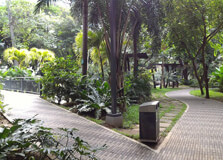
Washington SyCip Park, located in the bustling business district of Makati, is an urban oasis that offers a peaceful retreat from the fast-paced city life. This well-maintained park is named after Washington SyCip, a Filipino businessman, philanthropist, and founder of the Asian Institute of Management (AIM). It serves not only as a green space for relaxation but also as a venue for various outdoor activities, making it a popular spot for both locals and tourists. How to Reach Washington SyCip Park, Makati Washington SyCip Park is centrally located in Makati’s Ayala Triangle, making it easily accessible by various modes of transportation. Here’s how to get there: By Taxi or Ride-Hailing Apps: The easiest way to reach the park is by taking a taxi or ride-hailing service like Grab. Just input "Washington SyCip Park" in the app, and the driver will drop you off at the park's entrance. By MRT: The nearest MRT station is Ayala Station, which is about a 10-minute walk to the park. From there, you can walk through the pedestrian-friendly walkways of the Ayala Center to reach Washington SyCip Park. By Bus: Several buses pass through Ayala Avenue and nearby streets. You can alight at Greenbelt or Ayala Center, which are a short walk from the park. Walking: If you are staying near Ayala Center or Makati’s central business district, walking to the park is an excellent option, as it’s located in a pedestrian-friendly area with clear walkways. Weather and Best Time to Visit The weather in Makati is typically warm and humid year-round. The dry season, from November to February, offers cooler temperatures, making it the best time to visit Washington SyCip Park. During these months, the weather is ideal for a leisurely stroll or outdoor activities. However, the rainy season in the Philippines (June to September) brings frequent downpours, so it's advisable to check the weather forecast before visiting during this period. While the park is open year-round, it’s best to visit during the dry season to enjoy the full beauty of the park’s landscape. Why Washington SyCip Park is Famous Washington SyCip Park is known for being a peaceful sanctuary amidst the commercial hustle and bustle of Makati. Several factors contribute to its fame: Tranquil Escape: The park is an oasis in the heart of Makati, providing workers, residents, and tourists with a peaceful space to unwind. It is often regarded as one of the best green spaces in the city for relaxation and stress relief. Beautiful Landscape: The park features a mix of lush greenery, well-maintained walkways, sculptures, and a tranquil pond, making it a scenic spot for visitors to enjoy nature in the middle of the urban environment. Location: It is strategically located within the Ayala Triangle Gardens, surrounded by modern office buildings, shops, and restaurants. This central location makes it easy to visit during a break from work or while exploring the Makati business district. Tribute to Washington SyCip: The park is named after Washington SyCip, a renowned businessman who greatly contributed to the development of the Philippines' business and educational sectors. His philanthropic efforts are remembered and celebrated through this park. Entry and Visit Details Washington SyCip Park is open to the public free of charge. Visitors can enjoy the park at any time of the day, though it’s best to visit during the morning or late afternoon when the weather is cooler and more comfortable for outdoor activities. The park is well-lit at night, providing a safe environment for evening walks. The park is typically less crowded in the early morning, making it a great time for those who prefer a quieter experience. During lunch breaks or after work hours, the park can get busier, as it is a popular spot for office workers in the area to relax. History and Architecture Washington SyCip Park was developed as part of the larger Ayala Triangle Gardens project, which aims to create green spaces within the heart of Makati. The park was designed with sustainability in mind, incorporating both modern landscaping and elements that reflect Filipino heritage. Named after Washington SyCip, the park honors his contributions to the Philippines, especially in the fields of business and education. The park’s design includes beautifully manicured lawns, a peaceful pond, and artistic sculptures. It also features several trees and plant species that contribute to the overall atmosphere of tranquility and calm. Visitors can enjoy the natural beauty of the park, which seamlessly blends with the surrounding urban landscape. Things to Do at Washington SyCip Park Relax and Enjoy Nature: Washington SyCip Park is an ideal spot for relaxation. Take a leisurely walk along the pathways, sit by the pond, or enjoy the lush greenery. It’s a great place to escape the urban rush. Photography: With its beautiful landscape and sculptures, the park provides excellent photo opportunities. Visitors often take pictures of the scenic views, the tranquil pond, and the artistic pieces scattered throughout the park. Outdoor Exercise: Many visitors use the park for outdoor exercise such as walking, jogging, or stretching. The serene atmosphere makes it an excellent place for a morning workout or a cool-down after a day’s work. Explore Art Installations: The park features several sculptures and art installations, which add to the cultural value of the space. These artworks often reflect the rich Filipino heritage and are enjoyable for both art lovers and casual visitors. People-Watching: The park is also a good spot for people-watching, as it is frequented by locals, office workers, and tourists. Relax on one of the park’s benches and enjoy the diverse crowd around you. Facts and Tips about Washington SyCip Park Tip: If you’re visiting during the weekdays, try to go in the early morning to avoid the crowds, especially during lunch hours when office workers often take breaks in the park. Fact: Washington SyCip Park is not just a green space but also an area that promotes sustainability, with a design that incorporates eco-friendly features like rainwater harvesting and green landscaping. Tip: Wear comfortable shoes if you plan to walk or jog in the park, as there are several paths and walkways to explore. Fact: The park is dog-friendly, making it a great place to bring your furry companions for a walk, as long as they are on a leash. Tip: Bring a camera if you enjoy photography, as the park offers a variety of beautiful scenery, including sculptures, greenery, and city views.
Explore More